Pierogi are little semicircular parcels of pasta which are made with a multitude of fillings.
Even though I make these myself, it is the dish I always crave when I go to Poland.
There are several theories as to how pasta style dishes came into Poland.
The general word for pasta especially noodles is makaron , which certainly has its roots in Italian; and as Italian cooking has influenced Polish cooking from the 16th century I used to think that was where the dishes originated. I find it amusing that ravioli in Polish are called pierogi włoskie (Italian pierogi).
After doing some research it seems however that pierogi were around in Poland in the middle ages, they are mentioned in the 13th century and the name comes from an old Slav word for feast or festivity.
Many people believe that they came to Poland from the Far East through Siberia and Russia.
When I was in China in the 1990s, imagine my surprise when I was on several occasions offered dishes which were called Jiaoxi (dumplings) and they were exactly the same shape and size as pierogi and cooked in the same way!
Whatever the origins, the Poles have made pierogi their own; there are lots of traditional fillings, both savoury and sweet, and several ways of serving them.
In a pierogi cookery book I bought in Poland there are around 40 traditional ones and more than 20 new style ones. In a pierogi restaurant I went to in Kraków there were around 30 options on the menu.
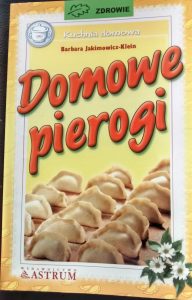
Pierogi
Pierogi are made from a thinly rolled out dough using a circular cutter, about 7 cm in diameter, we used to use a medium sized wine glass. A largish teaspoon of the filling is placed on the circle and this is then folded in half and the edges pinched together to seal them – this is done to give them a slightly crimped edge.
You learn from experience how much filling to put into the pierogi as too much will make it hard to seal them and if not properly sealed they will burst on boiling. Do not worry if you have a few mishaps – it still happens to me even with experience – it is hard to salvage one that has gone wrong – just accept that there will be a few that you do not cook.
Pierogi Dough
Pierogi dough is made from flour, egg and water and I have seen many variations of the recipe. The following is my mother’s and I think it is the best I have ever used and tasted.
She never used whole eggs, just the yolks and this gives a dough which is soft and not tough and can be easily rolled out. The recipes which use whole eggs give a tougher dough which is much harder to roll out.
My mother originally used plain flour and added a tablespoon or two of fine semolina but now that strong flour or even pasta flour is readily available this is what I use the most.
Another point is that flour does vary and it is possible to add more flour to the dough as you are mixing it but you cannot add more liquid if it is too dry!
As you mix the ingredients in the first few minutes you should be able to tell if it will be too dry and you can add some more water initially but once it is all mixed together you cannot – if it goes wrong – just start again.
The quantities that I have given work well and but you should allow for extra flour if needed.
Ingredients
- 500g pasta flour or strong flour or plain flour & 2 tablespoons of fine semolina
- 300 ml water
- 1 tablespoon oil – sunflower or light olive
- ½ teaspoon salt
- 2 egg yolks
Method
In a jug or bowl mix together the water, oil and yolks.
Put the flour and salt into a large bowl and make a well in the centre.
Pour the liquid mixture into the well and then with your hands incorporate the flour into the liquid until you have a large ball of dough.
Turn this out into a floured board and knead the dough for a few minutes until it is a smooth ball.
You can then use the dough straight away, cutting it into 4 quarters and rolling out a quarter at a time on a floured surface until the dough is thin. You can pull it out a bit at the beginning to give a more rectangular shape of even thickness.
You can cover the dough with a cloth and place it in the fridge till needed.
You can freeze the dough for a few days for later use, it is best to cut it into quarters and wrap these in cling film or plastic and place these in another bag or container.
Shaping The Pierogi
Rolled out the dough until it is thin and use a circular cutter, about 7cm in diameter, to make lots of circles. You can re-roll the cuttings to make more circles until all the dough is used.
A largish teaspoon of the filling is placed on to the dough circle and this is then folded in half and the edges pinched using your thumb and first finger to seal them – giving them a slightly crimped edge.
This quality of dough will make about 70 to 80 pierogi – depends on how thinly you roll the dough and the size of your cutter.
You can open freeze pierogi so sometimes I make a batch and open freeze half of them – then store them in a plastic box. They should be cooked from frozen just allowing a little extra time.
Pierogi Fillings
The quantities that I have given should be enough for the 500g batch of dough. Many of the fillings once made can be frozen; I sometimes make the mixture and freeze it in 2 to 3 small batches for later use.
A good tip is not to make the filling too moist, as any liquid on the dough will prevent you getting a good seal.
Have a large surface such as a tray covered with a cotton or linen cloth which has been lightly floured ready and place the sealed pierogi on this until they are all made, do not let then touch each other.
Cooking The Pierogi
To cook the pierogi, use a large pan of boiling water to which you have added some salt and a drizzle of oil. Drop the pierogi in one by one and allow them to boil. I usually do about 6 to 8 at a time (I only do 6 at a time if using frozen ones). As they cook they will float to the surface, let them boil for 2 to 3 minutes, a bit more if they were frozen, and then remove them with a slotted or perforated spoon and put into a colander above a pan for a few seconds to drain and serve. Continue boiling batches in the same water.
Serving Suggestion
Traditionally savoury pierogi are served with melted butter, skwarki – crispy smoked bacon bits, small pieces of fried onion or melted butter and dried breadcrumbs (à la Polonaise).
If you want to make all the pierogi to serve together then you need to get a large shallow dish and put the melted butter or skwarki or fried onions into the dish and keep the dish warm in a low oven. As you take out the cooked pierogi add them to the dish, mix them with the butter, skwarki or onions to prevent them sticking. Keep on adding more as they cook and keep shaking the dish to coat and mix them.
Once your have had your meal and you have any left (I leave some deliberately) then they are wonderful fried up later. You need a hot frying pan and should be able to just use the butter etc that they are coated in, maybe adding a little extra oil if needed. Fry them till the dough is golden and crispy.
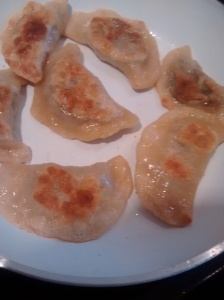
Tip – spread out the cooked and coated pierogi for later frying to prevent them sticking
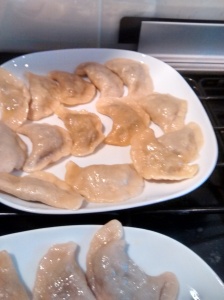
Savoury Fillings
Below are some of my favourite fillings.
All the filling must be allowed to cooled before using them – you can make these in advance – even the day before.
Sauerkraut & Mushroom
These is often served at Wigilia – the Christmas Eve meal
Ingredients
- Approx 500g of sauerkraut (I used to get small jars but have not seen these lately – use part of a large jar – use the rest for something else)
- 20- 30g dried mushrooms.
- 1 onion
- 1 bay leaf
- Ground black pepper to taste
Method
Put the mushrooms in a small bowl and cover them with boiling water and leave them overnight.
Strain the mushrooms but keep the liquid and then chop the mushrooms into small pieces.
Strain the sauerkraut but keep the liquid and chop the sauerkraut into small pieces.
Put the sauerkraut with the liquid from the tin or jar into a pan and cover with boiling water. Add some of liquid from the soaked mushrooms and the bay leaf.
Cover the pan and boil the sauerkraut gently for about 30 minutes. Then uncover and boil off as much of the liquid as possible – without burning the sauerkraut.
Allow the boiled sauerkraut to cool and remove the bay leaf. Strain it using a sieve and pressing it down with a spoon to get the mixture as dry as possible (If you want you can put the strained mixture into a clean dry cotton or linen teacloth, twist the ends together to squeeze it to get it really dry).
Whilst the sauerkraut is cooking heat the chopped mushrooms gently in a small pan with the rest of the liquor, stirring to prevent it burning but reducing as much of the possible.
Chop the onion finely and fry it till it is soft and golden and add this to the mushroom mixture and mix it well together.
Mix the sauerkraut, mushrooms and onions together and add some ground black pepper to taste; salt should not be necessary.
Note
If your sauerkraut is very sour, you can add a little sugar to the mixture or you can put it into a sieve or colander and wash it for a few minutes in cold water before you start cooking it – you might want to add a little salt at the end if you use this method – taste and see)
Cheese 1
400g floury potatoes
1 onion
200g curd cheese/twaróg or yoghurt cheese
1 egg yolk
butter & oil to fry the onion
salt & ground black pepper to taste
Method
Peel and boil the potatoes in salted water, strain and mash, then leave to cool.
Chop the onion finely and fry it till it is soft and golden, allow it to cool.
Mix together thoroughly, the potatoes, onions, cheese and egg yolk.
Add salt and pepper to taste.
Cheese 2
When my mother did not have any curd cheese, she used Lancashire cheese, as that was the cheese most readily available to her. Both versions taste good, the secret with this one is to grate the cheese as finely as possible and mix it in well.
Ingredients
400g floury potatoes
1 onion
200g white crumbly cheese such as Lancashire
1 egg yolk
butter & oil to fry the onion
salt & ground black pepper to taste
Method
Peel and boil the potatoes in salted water, strain and mash, then leave to cool.
Chop the onion finely and fry it till it is soft and golden, allow it to cool.
Grate the cheese as finely as possible.
Mix together thoroughly, the potatoes, onions, cheese and egg yolk.
Add salt and pepper to taste.
Note
My mother would boil extra potatoes on one day and save some to make these fillings the next.
In Poland you may see these savoury cheese ones on a menu as Pierogi ruskie – that is Ruthanian pierogi – from the old word for the Ukraine
Pork
Ingredients
300g shoulder or spare rib pork
1 onion
1 egg yolk
1 tablespoon of dried breadcrumbs
approx 250 ml of chicken stock – can be from stock cubes
butter & oil to fry the onion
salt & ground black pepper to taste
Method
Pre heat the oven to GM 3 – 1600C
Put the pork into a small casserole dish and cover it with the stock and put on the lid.
Put the dish in the oven for at least 1 hour, depending on the meat you might need longer.
I cook the meat until it is tender and can be broken up with a fork and most of the liquid has been absorbed. Allow the meat to cool. You can mince the meat but I find that if you cook it long enough you do not need to, you can just chop it with a sharp knife .
Chop the onion finely and fry it till it is soft and golden, allow it to cool.
Mix thoroughly together: the meat, onion, yolk and breadcrumbs and then add salt and pepper to taste.
Chicken
You can cook a piece of breast chicken as for the pork filling, however neither my mother or myself ever did this; we used leftover roast chicken from a roast dinner.
Ingredients
- 300g of roast chicken
- 1 onion
- 1 egg yolk
- 1 slice of white bread
- small amount of milk
- butter & oil to fry the onion
- salt & ground black pepper to taste
Method
Take the slice of bread and remove the crusts removed and leave this for half an hour in a bowl with a little milk – do not use the excess milk just the wet slightly squeezed bread.
Finely chop or mince the chicken.
Mix together the chicken, onion, egg yolk and bread to get a uniform mixture.
Sweet Fillings
The dough and method of making sweet pierogi is just the same as for the savoury ones.
Once boiled sweet pierogi are dredged with icing or caster sugar and are often served with soured cream. They are best eaten straight away.
I must admit that when I was younger I did not really like sweet pierogi but now I think they are utterly delicious especially when with soured cream.
Sweet Cheese 1
Ingredients
200g curd cheese/twaróg or yoghurt cheese
40g caster sugar
1 egg yolk
2 drops of vanilla essence
tiny pinch of salt
Method
Thoroughly mix all the ingredients together.
Sweet Cheese 2
Ingredients
250g curd cheese/twaróg or yoghurt cheese
40g caster sugar
2-3 tablespoons of soured cream
tiny pinch of salt
Method
Thoroughly mix all the ingredients together.
Red Fruits
In the summer in Poland, when all the fruits of the forests and the garden are ripe, that is when these pierogi are at their best. However bottled fruit is available all year round and I often make my sweet pierogi with these.
The following fruits are traditionally used –
Morello Cherries
Blackberries
Whinberries (bilberries) these grew in Lancashire near my home and also could be bought in baskets imported from Poland. (I think the larger American Blueberry is nowhere near as tasty.) When we went to pick these I know this always made my mother think of her childhood in Poland.
I tend to use half the amount of dough when making these fruit ones as they do not freeze well with fruit.
Depending on the size of the fruit, you need about 3 or 4 per circle.
Do not add sugar to fresh fruit as this will make too much liquid and the pierogi will not seal.
If using bottled fruit you need to strain as much juice away as possible.
Drenched the cooked pierogi in icing sugar and serve with sour cream. The sugar contrasts with tartness of the fruit.
A Variation ….
Knedle – Dumplings – With Plums
To me these are sweet pierogi – but I have been assured by my aunties in Poland – who made them for me on my last visit – that because of their shape – round balls – these are always called knedle.
The dough is just the same as for pierogi and they are boiled in just the same way but will take a bit longer to cook depending on the size of the plums.
Serve them dusted with icing sugar and serve with soured cream.
Plum Filling
500g fresh plums – small ones are best for the round shape & sugar – you will need about a half a teaspoon per plum.
Wash and dry the plums and remove the stalks. If the plums are small then use whole ones and if they are large use a sharp knife to cut them in half and remove the stone.
Cut strips of dough more than twice the size of the plum or plum half. Place the plum on one side and sprinkle with the sugar.
Fold over the other part of the dough and seal the edges well with your fingers – take care as the added sugar produces liquid – use excess dough to give a good seal then cut away the excess dough to give a more rounded shape.
Uszka
Uszka – means ‘little ears’ and they are much smaller and a different shape than pierogi and are always savoury.
They are made from squares of dough, about 4cm square. Half a teaspoon of filling is placed onto the square and then it is folded into a triangle and the edges sealed. The two ends at the folded side of the triangle are brought together and then pinched together giving a shape which is slightly rounded triangle with a pointed part, looking like a little ear.
When you have rolled out the dough until it is thin you cut the dough into squares no more than 4cm square. I used to use a sharp knife but have now found that using a pizza wheel to cut the dough is much easier. There is little waste dough with each rolling but you can still use all the scrapes to make one last batch.
The quality of dough will make about 150 and because of this I often only make half quantities – using 250g of flour, 150ml of water, 1 egg yolk and half a tablespoon of oil. (Except at Wigilia – the Christmas Eve meal, when I make the full amount)
The uszka are boiled in just the same way as pierogi, they are usually ready when they float to the surface.
The most traditional fillings are mushroom – see below – and Sauerkraut & Mushroom.
Uszka can be served just as pierogi with melted butter or they can be served floating in a clear soup such as rosól – clear chicken soup or in barszcz – beetroot soup.
Traditionally mushroom uszka are made for Wigila – the Christmas Eve meal either on their own with butter or served floating in barszcz (clear beetroot soup).
Mushroom Filling
In Poland these will have been made with just dried mushrooms, here in England my mother made them with fresh mushrooms with the addition of dried mushrooms when she could get them. I like them like this the best.
Ingredients
250g mushrooms – older open ones are better than button mushrooms.
20g dried mushrooms
1 onion
1 egg yolk
1 to 2 tablespoons of home-made dried breadcrumbs
butter to fry the mushrooms
salt & ground black pepper to taste
Method
Pour a small amount of boiling water into the dried mushrooms and leave these overnight.
You can remove the stalks from the older fresh mushrooms as these tend to be ‘woody’ and then cut them into thin slices.
Chop the onion into small pieces.
Fry the mushrooms and onions together in the butter. It does depend on the mushrooms and the way they are fried as to how much liquid is produced, if you get a lot, then let them simmer gently to evaporate as much as possible or strain some of this excess off (you can use this liquor in soups or sauces).
Allow the mixture to cool.
Chop the reconstituted dried mushroom (again you can save the liquor for other recipes) and add these to the mixture.
The mixture then needs to be minced which used to take me a long time and much effort. I now use a hand blender which works really well taking care not to liquidise it too much.
To the minced mixture add the egg yolk and then enough breadcrumbs to make a stiff filling.
Add salt and lots of ground black pepper.
Cut the dough into quarters
On a floured board roll out each piece until it is thin.
Using a sharp knife or pizza wheel cut the dough into 4cm squares (they can be smaller but they are harder to work).
Fold over each piece to form a triangle and pinch the edges together with your fingers.
Half a teaspoon of filling is placed onto the square and then it is folded into a triangle and the edges sealed. The two ends at the folded side of the triangle are brought together and pinched together giving a shape which is slightly rounded triangle with a pointed part.
They are cooked just as the pierogi in boiling water with the addition of salt and oil.
I serve them with melted butter.
If you are going to add them to soup do not coat them with butter – 2 to 4 are added to each serving.
Our New Tradition
After the Wigilia meal on Christmas Eve we always leave some uszka for the Christmas Day breakfast and we have fried eggs, grilled bacon with fried uszka – delicious!
PS
This must be my longest post as there is so much to say – I have only touched on the fillings that you can use & you can always make up your own.
















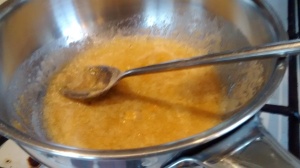
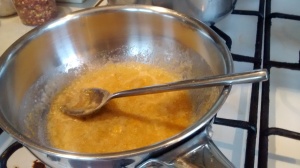



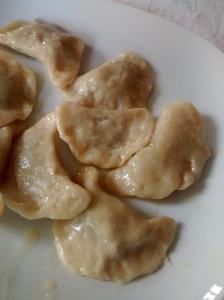
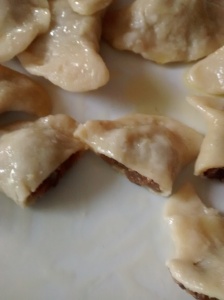
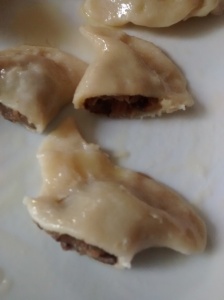




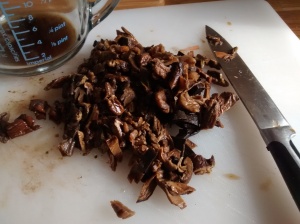
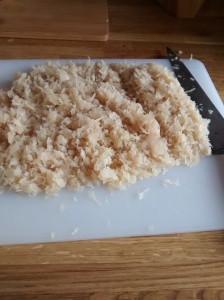











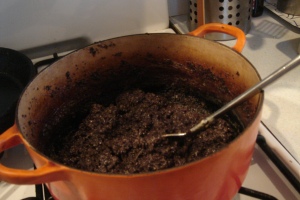


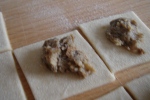
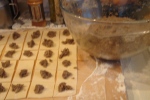
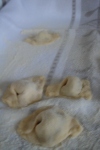
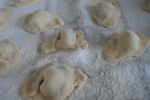

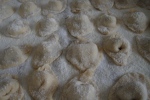
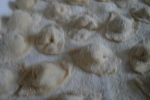

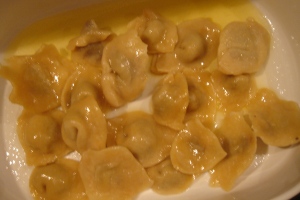
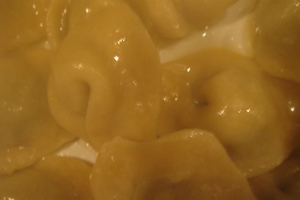
Oh wow! I have to say I’m particularly tempted by the idea of cherry ones! 🙂
LikeLike
The contrasts in tastes – tart dark cherries, sour cream & icing sugar, does make them super
LikeLiked by 1 person
I love looking at your cookery posts – the recipes are great and the additional pieces of information are brilliant. Just read the one on pierogi – I want to go home and make some instantly!
LikeLike
The filling I made for the sauerkraut & mushroom ones for the photos was the best ever, I had a great time eating these!
LikeLike
I’m sure it was pierogi that the Hairy Bikers made when they made a trip to Poland. would love to try these sometime. Any this weekend? Only kidding😆😆😆
LikeLike
They did, I have that episode recorded. I did not like the way they made them, and they were too big.
I think I made them with the mushroom filling for you a few years ago.
LikeLiked by 1 person